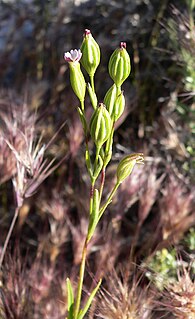
Silene antirrhina is a species of flowering plant in the family Caryophyllaceae known by the common names sleepy silene and sleepy catchfly. It is native to the Americas, where it is widespread throughout North America and parts of South America. It is known in Europe as an introduced species.

Silene bernardina is a species of flowering plant in the family Caryophyllaceae known by the common name Palmer's catchfly.
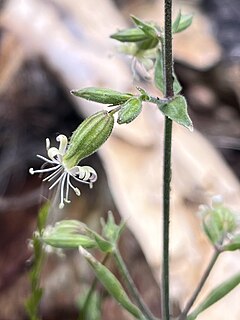
Silene bridgesii is a species of flowering plant in the family Caryophyllaceae known by the common name Bridges' catchfly. It is native to California, where it can be found throughout the Sierra Nevada and the southern reaches of the Cascade Range to the north, its distribution possibly extending into Oregon. It grows in mountain forests and woodlands. It is a perennial herb growing from a taproot and woody caudex unit, its stem decumbent or growing erect to half a meter or more in height. It is hairy, the upper hairs glandular, making the plant sticky in texture. The lower leaves are widely lance-shaped, up to 8 centimeters long by 1.5 wide. Upper leaves are smaller. Flowers occur in a terminal cyme at the top of the stem, as well as in some of the leaf axils, where they nod or hang like a bell. Each has a hairy, glandular calyx of fused sepals with ten veins. The calyx is open at the tip, revealing five white, pinkish, or greenish petals each with two rectangular lobes at the tip. The very long stamens and three styles protrude from the flower's center.

Silene campanulata is a species of flowering plant in the family Caryophyllaceae known by the common names Red Mountain catchfly and bell catchfly. It may be a synonym of Silene greenei.

Silene douglasii is a species of flowering plant in the family Caryophyllaceae known by the common name Douglas's catchfly.

Silene gallica is a species of flowering plant in the family Caryophyllaceae known by several common names, including common catchfly, small-flowered catchfly, and windmill pink. It is native to Eurasia and North Africa, but it can be found throughout much of the temperate world as a common roadside weed.
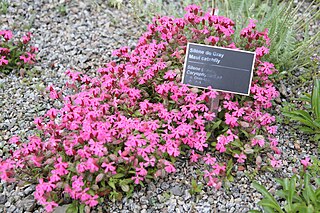
Silene grayi is a species of flowering plant in the family Caryophyllaceae known by the common name Gray's catchfly. It is native to the mountains of Oregon and northern California, including the Klamath Mountains, where it grows in chaparral, mountain forests, and the talus of high slopes in alpine climates. It has been observed to occur in a plant association with oceanspray, littleleaf silverback, and Gray's bedstraw. It is a perennial herb producing a decumbent or erect stem up to 20 or 30 centimeters long from a woody, branching caudex. The base of the plant is covered in tufts of leaves. These basal leaves are lance-shaped to nearly spoon-shaped, fleshy, and up to 4 centimeters long. Smaller, narrower leaves occur farther up the stems. Each flower has a tubular calyx of fused sepals lined with ten green or red veins and covered in glandular hairs. It is open at the tip, revealing five pink or purple petals. The petal tips and appendages are divided into narrow lobes.
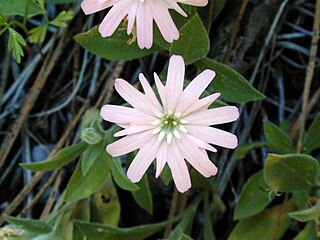
Silene hookeri is a species of flowering plant in the family Caryophyllaceae known by the common names Hooker's silene, Hooker's catchfly, Hooker's Indian pink, and Hooker's glandular campion.
Silene salmonacea is a rare, newly described species of flowering plant in the family Caryophyllaceae known by the common names Klamath Mountain catchfly and salmon-flowered catchfly. It is known only from Trinity County, California, where it grows in the forests of the southern Klamath Mountains. It is a member of the serpentine soils flora. It is a small perennial herb growing just a few centimeters tall. The spoon-shaped leaves are up to 3.5 centimeters long. The herbage is gray-green and lightly woolly in texture. Each flower has a tubular calyx of fused sepals lined with ten veins. There are five salmon pink petals, each with four lobes at the tip.

Silene invisa is a species of flowering plant in the family Caryophyllaceae known by the common names red fir catchfly and short-petaled campion.

Silene lemmonii is a species of flowering plant in the family Caryophyllaceae known by the common name Lemmon's catchfly.

Silene noctiflora is a species of flowering plant in the family Caryophyllaceae known by the common names night-flowering catchfly, nightflowering silene and clammy cockle. It is native to Eurasia, but it is known on other continents as an introduced species and sometimes a weed. In North America, it is a common weed of grain crops in the Canadian prairie provinces and in much of the United States. It grows in fields and in other disturbed habitat.
Silene nuda is a species of flowering plant in the family Caryophyllaceae known by the common names western fringed catchfly and sticky catchfly.

Silene occidentalis is a species of flowering plant in the family Caryophyllaceae known by the common names western catchfly and western campion.
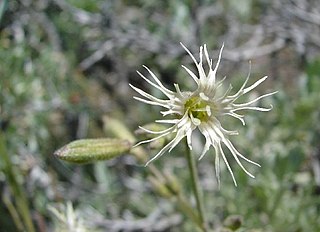
Silene oregana is a species of flowering plant in the family Caryophyllaceae known by the common names Oregon silene, Oregon campion and Oregon catchfly. It is native to the western United States, including the Great Basin, where it grows in habitat such as sagebrush and forests. It is a perennial herb growing from a woody caudex and taproot, sending up an erect, mostly unbranched stem which may be 70 centimeters tall. The lance-shaped leaves are up to 8 centimeters long around the caudex, and shorter farther up the stem. Flowers occur in a terminal cyme and sometimes in leaf axils. Each flower is encapsulated in a hairy, glandular calyx of fused sepals. The five petals are creamy white or pink-tinged in color and each has four to six long, fringelike lobes at the tip.

Silene sargentii is a species of flowering plant in the family Caryophyllaceae known by the common name Sargent's catchfly. It is native to the western United States, where it is known from the mountain ranges straddling the California-Nevada border east of the Sierra Nevada. It is also known from one disjunct occurrence in central Washington. It grows in rocky mountain habitat in subalpine and alpine climates. It is a perennial herb growing from a woody, branching caudex and taproot, sending up several decumbent or erect stems and shoots. It grows no more than about 20 centimeters tall, often taking a clumpy form. The fleshy leaves are widely lance-shaped and a few centimeters in length, most of them occurring around the caudex. Each flower is encapsulated in a hairy, glandular calyx of fused sepals which has stark purple veining. The petals are white to deep pink and each has two or more rounded or pointed lobes at the tip.
Silene suksdorfii is a species of flowering plant in the family Caryophyllaceae known by the common names Suksdorf's silene, Suksdorf's catchfly and Cascade alpine campion. It is native to the Pacific Northwest of the United States, where it occurs from Washington and Idaho to northern California. It is mainly an alpine species, growing in the talus of high mountain slopes. It can also be found below the tree line in forested subalpine habitat. It is a squat perennial herb producing several erect stems from a leafy, woody caudex. It generally takes a clumpy form. The stems grow up to 10 or 15 centimeters tall and are hairy in texture, with glandular, sticky areas on the upper parts. The leaves occur in tufts around the caudex. They are fleshy and coated in soft hairs. Solitary flowers arise on erect peduncles. Each is encapsulated in an inflated calyx of fused sepals, which is starkly purple-veined and has purplish glandular hairs. The petals are white or purple-tinged and have two lobes at their tips and appendages at their bases.
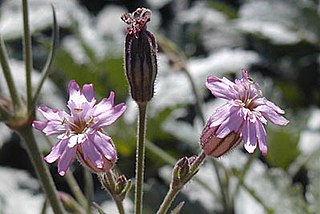
Silene verecunda is a species of flowering plant in the family Caryophyllaceae known by the common name San Francisco campion.

Trifolium angustifolium is a species of clover known by the common names narrowleaf crimson clover, narrow clover and narrow-leaved clover.

Silene polypetala is a rare species of flowering plant in the family Caryophyllaceae known by the common names eastern fringed catchfly and fringed campion. It is native to Georgia and northern Florida in the United States. It is threatened by the loss and degradation of suitable habitat. It is a federally listed endangered species of the United States.


















